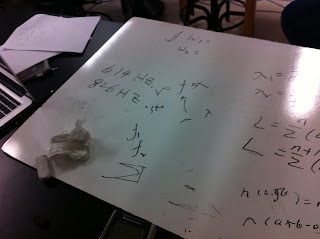Question 1: Distance traveled by the light pulse
How does the distance traveled by the light pulse on the moving light clock compare to the distance traveled by the light pulse on the stationary light clock?
A: It's longer than the distance on the stationary clock.
Question 2: Time interval required for light pulse travel, as measured on the earth
Given that the speed of the light pulse is independent of the speed of the light clock, how does the time interval for the light pulse to travel to the top mirror and back on the moving light clock compare to on the stationary light clock?
Given that the speed of the light pulse is independent of the speed of the light clock, how does the time interval for the light pulse to travel to the top mirror and back on the moving light clock compare to on the stationary light clock?
A: The time is longer than it will take compare to the one on the stationary station.When the light clock is moving, the light pulse must travel along the hypotenuse of a right triangle
whose legs are formed by the distance that the light clock moves and the distance between the light
clock's mirrors.
Question 3: Time interval required for light pulse travel, as measured on the light clock
Imagine yourself riding on the light clock. In your frame of reference, does the light pulse travel
a larger distance when the clock is moving, and hence require a larger time interval to complete a single round trip?
A:If I am the one on the light clock, the time i measured will be the same as the stationary light clock. Since the light pulse always travels the same distance, it always takes
the same amount of time.
Question 4: The effect of velocity on time dilation
Will the difference in light pulse travel time between the earth's timers and the light clock's timers
increase, decrease, or stay the same as the velocity of the light clock is decreased?
A:As the speed of the light clock is reduced, the difference between the
distance traveled by the light pulse and the distance between the
mirrors decreases. As this distance difference decreases, the time
difference also decreases.
A: The time the outside observer observed appeared to decreased as the velocity of the light clock moving increase.
Question 5: The time dilation formula
Using the time dilation formula, predict how long it will take for the light pulse to travel back and forth between mirrors, as measured by an earth-bound observer, when the light clock has a Lorentz factor (γ) of 1.2.
Set γ = 1.2 and run the simulation to check your prediction.
A: It's 8.00microseconds! The proper time interval does not depend on the speed of the light clock. The time interval measured by an earth-bound observer is the product of the proper time interval and the Lorentz factor.
Question 6: The time dilation formula, one more time
If the time interval between departure and return of the light pulse is measured to be 7.45 µs by an earth-bound observer, what is the Lorentz factor of the light clock as it moves relative to the earth?
If the time interval between departure and return of the light pulse is measured to be 7.45 µs by an earth-bound observer, what is the Lorentz factor of the light clock as it moves relative to the earth?
A: The Lorentz factor is the ratio of the observer's time interval measurement to the proper time interval, (7.45 µs) / (6.67 µs) = 1.12.
Question 1: Round-trip time interval, as measured on the light clock
Imagine riding on the left end of the light clock. A pulse of light departs the left end, travels to the right end, reflects, and returns to the left end of the light clock. Does your measurement of this round-trip time interval depend on whether the light clock is moving or stationary relative to the earth?
A: The measurement of this round-trip time interval depends on whether the light clock is moving or stationary relative to the earth.
Question 2: Round-trip time interval, as measured on the earth
Will the round-trip time interval for the light pulse as measured on the earth be longer, shorter, or the same as the time interval measured on the light clock?
A:The round-trip time interval for the light pulse as measured on the earth will be shorter than the time interval measured on the light clock.
Question 3: Why does the moving light clock shrink?
Question 4: The length contraction formula
A light clock is 1000 m long when measured at rest. How long would earth-bound observer's measure the clock to be if it had a Lorentz factor of 1.3 relative to the earth?
A: L = 1000/1.3m = 769m
























